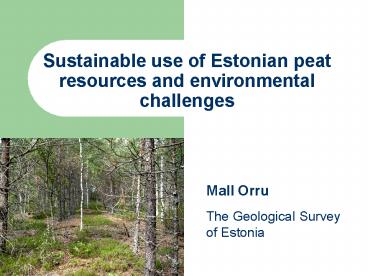Sustainable use of Estonian peat resources and environmental challenges - PowerPoint PPT Presentation
1 / 24
Title:
Sustainable use of Estonian peat resources and environmental challenges
Description:
Sustainable use of Estonian peat resources and environmental challenges Mall Orru The Geological Survey of Estonia – PowerPoint PPT presentation
Number of Views:108
Avg rating:3.0/5.0
Title: Sustainable use of Estonian peat resources and environmental challenges
1
Sustainable use of Estonian peat resources and
environmental challenges
- Mall Orru
- The Geological Survey of Estonia
2
Background
- Peatlands cover 22.3 of Estonian territory (1
009 100 ha) - 60 of peatlands are formed as paludification of
mineral soils and 40 as lake paludification - Total number of the peatlands is 9836 85 of
them are small (1-10 ha) - Average thickness of peat layer is 3-4 m
3
Background
- Peatlands cover 22,3 of Estonian territory (1
009 100 ha) - 60 of peatlands are formed as paludification of
mineral soils and 40 as lake paludification - Total number of the peatlands is 9836, 85 of
them are small (1-10 ha) - Average thickness of peat layer is 3-4 m
4
Investigation of Estonian peatlands
- Work started in 1967 in the Geological Survey of
Estonia (EGK) - All mires with area gt1 ha were investigated and
mapped (110 000, 125 000) - Thickness of peat layer, peat type, ash content,
pH, moisture, hydrological, and geological
condition were studied - 70 000 samples were analysed in laboratory
5
Environmental register, list of deposits
- Started in 1996 in EGK, recently hold by Estonian
Land Board - List of deposits consists 279 peat deposits
- Area of peat deposits is 260 000 ha, which
contains 26 of total peatlands area and 8 of
Estonian territory - List of deposits is complemented constantly
6
Peat resources
Active proved reserves 0.22 billion tonnes
Active probable reserves 0.82 billion tonnes
In list of peat deposits 1.60 billion tons (16
light humified, 84 well humified)
Total resources 2.37 billion tons
Passive reserves 0.56 billion tonnes
7
Peat extraction
- It is extracted from 77 deposits
- Production fields area is 20 550 ha
- Peat is mainly used for horticulture and fuel
- Peat production ranges from 0.9-1.5 million tons
8
According to the Sustainable Development Act
the extraction can not exceed 2.6 million tons
per year
9
Mire protection
- Mire protection area 161 575 ha
- With Natura 2000 protected areas 211 421
ha - 72 of them are raised bogs
- 22 of Estonian mires are under protection
10
Alternative use of peat
- Environmental technological solutions
- Like sorbents, wastewater treatment etc.
- Peat balneology
- Research has been carried out by EGK
- Clinical experiments in progress
11
Abandoned peat production areas
- 154 abandoned peat production areas in Estonia
with area 8500 ha - Peat reserves not totally exhausted yet there
- High CO2 emission due peat humification
- Peat mineralises in such areas
12
Revision of abandoned peat production areas
- Carried out by EGK since 2005
- At the end of 2007 the revision will be completed
in 12 counties - Study questions
- remained peat resources
- state of water regime
- drainage network
- revegetation etc.
13
Põlliku peatland
14
Põlliku peatland 2
15
Imsi peatland
16
Hõreda peatland
17
Rabivere peatland
18
Viru peatland
19
Hara peatland
20
Hara peatland 2
21
As the results of the study
- To provide information for decisionmakers weather
re-establish mire, turn into wetland, reforest,
plant with berries or make a body of water - The above-described problem is topical in the
other countries as well
- In 2008, XIII International peat Congress
- After Wise Use the Future of Peatlands
- will be organised by the International Peat
- Society in Tullamore, Ireland
22
Plantation of berries
- Plantation of cranberries and blueberries in
abandoned peatlands - Studies carried out by Estonian University of
Life Sciences
23
Conclusions
- Continue and develop sustainable use of peat
resources and peatlands - Find alternative usage for peat
- Better co-operation between scientists,
decisionmakers, peatproducers etc. - Make the linking of borders of peat deposits,
protection areas, and peat production available - Improve scientific studies of abandoned peat
areas - multidisciplinary analyses geologist,
ecologist, botanist, hydrologist
24
Thank you for your attention!
- Contact orru_at_egk.ee































